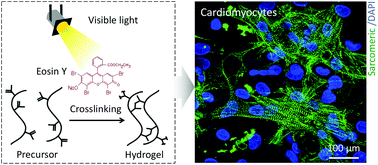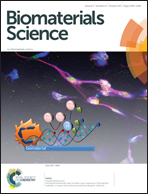In vitro and in vivo analysis of visible light crosslinkable gelatin methacryloyl (GelMA) hydrogels†
Abstract
Photocrosslinkable materials have been frequently used for constructing soft and biomimetic hydrogels for tissue engineering. Although ultraviolet (UV) light is commonly used for photocrosslinking such materials, its use has been associated with several biosafety concerns such as DNA damage, accelerated aging of tissues, and cancer. Here we report an injectable visible light crosslinked gelatin-based hydrogel for myocardium regeneration. Mechanical characterization revealed that the compressive moduli of the engineered hydrogels could be tuned in the range of 5–56 kPa by changing the concentrations of the initiator, co-initiator and co-monomer in the precursor formulation. In addition, the average pore sizes (26–103 μm) and swelling ratios (7–13%) were also shown to be tunable by varying the hydrogel formulation. In vitro studies showed that visible light crosslinked GelMA hydrogels supported the growth and function of primary cardiomyocytes (CMs). In addition, the engineered materials were shown to be biocompatible in vivo, and could be successfully delivered to the heart after myocardial infarction in an animal model to promote tissue healing. The developed visible light crosslinked hydrogel could be used for the repair of various soft tissues such as the myocardium and for the treatment of cardiovascular diseases with enhanced therapeutic functionality.

- This article is part of the themed collections: Biomaterials Science 10th Anniversary: Top papers from North America and Biomaterials Science Lectureship Winners


 Please wait while we load your content...
Please wait while we load your content...